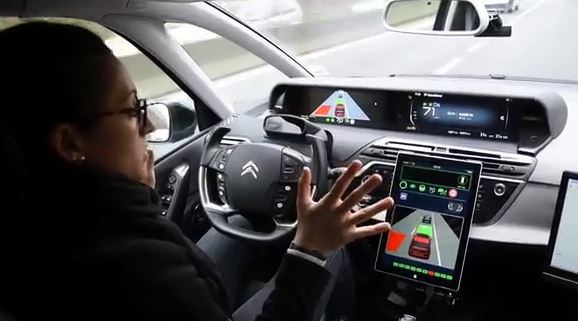 Is PSA Group encouraging open innovation?
Is PSA Group encouraging open innovation?
Innovation is a way of opening the company to all external ecosystems. Open innovation has been implemented at PSA Group for at least five years and is completely integrated in our DNA of innovation.
What can you tell us about the PSA Group’s The Business Lab?
It was launched at the end of 2016 to meet the rapid development of new automobile uses. One of its missions is to identify disruptive start-ups via the different strategic pillars of our innovation strategy. So its role is to detect, experiment and transform opportunities into new businesses for the Group, particularly with regard to mobility and digital issues. We also have a global network of innovation cells that are looking at what tomorrow’s start-ups could be.

What about the StelLab?
The StelLab is an international, dedicated scientific network of universities and academics supporting automotive research. We have more than 15 open labs in France, five in China and are now deploying them in Morocco. The academic ecosystem is, from my point of view, a key strength of our open innovation strategy.
We have also launched different incubators internally where any member of the Group can enter an incubator and propose an idea. We then try to facilitate and help develop new businesses from these ideas and to identify new opportunities or spin-offs.
What are the strategic pillars of your innovation strategy?
The first is clean technologies—how we prepare the technologies of tomorrow that will ensure we have the necessary opportunities to provide our customers sustainable mobility solutions. The second is autonomous and connected vehicles. And the third, very importantly for PSA Group, is what we call the brand attractiveness pillar. Its main purpose is to be sure that, from an innovation point of view, we contribute to provide the best innovation solutions for each of our brands. By this I mean lighting solutions, disruptive solutions, etc. A good example of this is the “Citroën Advanced Comfort” developed by Citroën.
How does a traditional automaker embrace the digital age?
Digital is a way of changing a company, changing its processes, and also giving a company the opportunity to improve its efficiency. When we refer to digital, from an R&D point of view, we also refer to the opportunities available today from a simulation point of view. Relying on digital validation rather than conventional prototype and physics phases, offers a huge opportunity to increase and improve our efficiency. Digital also provides us with new tools to ensure that new functions perform to the high safety standards that we want to provide our customers
How will autonomous driving change the game?
Autonomous driving will provide a new source of freedom to our customers. The autonomous functions will allow the driver to choose when the wish to drive. They can switch on the pilot system and continue to do whatever they want. It will help them save time. From a technical point of view, autonomous driving will lead to safer road mobility. Today, more than 90 percent of accidents are due to human failure. Implementing these new autonomous functions will also lead to improved safety on the roads.
“What excites me the most are the new experiences and solutions in mobility. We are at a time when technology is spreading and moving increasingly fast: autonomous driving and electro-mobility solutions integrated with clean and sustainable technologies.” Carla Gohin, Head of Innovation, PSA Group
Could you give us an overview of PSA Group’s developments in autonomous driving?
The level 2 (“hands-off”) functions will be available in 2018. The driver is still there, supervising and the responsibility is still their own. These automated driving functions “under driver’s supervision” constitute the second phase of the AVA “Autonomous Vehicle for All” program.
Some level 2 functions will be launched on the DS 7 Crossback. The vehicle manages its speed and controls its route. “Connected Pilot” offers complete assistance on fast roads. The vehicle parks itself without the driver’s assistance thanks to “Park Pilot”. Embedded vehicle equipment identifies obstacles and ensures increased night visibility via “Night Vision”. A camera inside the vehicle monitors the driver’s attention through “Driver Attention Monitoring”.
Level 3 (“eyes-off”) functions, will enable the driver to completely delegate driving to the vehicle and thus do other things. These will begin implementation by 2021. Level 4 (“minds-off) should be introduced in 2023 or 2024 and will give the car total responsibility for safety. The driver could even sleep during the ride providing certain driving conditions. Level 5 will be the driverless car, the autonomous shuttles or the robot taxis. They will mostly be implemented after 2025.
All of these five levels are completely integrated in our AVA program. We are implementing each of the levels throughout different launches across our three brands.

What are the main challenges to autonomous driving?
The first one is safety. At level 1, as of today, and at level 2, which is coming next year, the driver is still responsible for safety. When we advance to the new world of level-3 functions, we have a greatly increased duty in terms of safety. We want to be certain that the solutions we provide our customers, with regards to safety, are state-of-the-art.
The second challenge is regulation. Policies are changing and being updated, but technology is moving much faster than the policies concerning autonomous driving. We must be sure that regulation will change at the same rate at which we are implementing new technologies.
The third challenge is sensor technology. We still have some technical challenges to overcome and be certain that we have found the best solution. Another issue will be defining this new experience of driving. We have to be sure that our customers will accept the new functions as the relationship between a customer and their car will change completely.
The last challenge is an economic one. We will be using a lot of new technology, sensors, ICUs, etc. and they cost money. We must make sure that these new technologies will be available and affordable for the majority of our customers.
What are PSA Group’s main competitive advantages in autonomous driving technologies?
Principally our expertise. We are the first to be testing these new cars on open roads. We have already driven more than 120,000km on autonomous modes. We have some of the best, state-of-the-art expertise in this area.
Our second competitive advantage is that we are the first to have the authorization to travel in Europe (in France). Additionally, our program aims to provide autonomous mobility for all. That is quite different from the perspective of other OEMs (Original Equipment Manufacturers). We must provide a portfolio of mobility solutions for every one of our customers.
- Open innovation is the use of purposive inflows and outflows of knowledge to accelerate internal innovation, and expand markets for external use of innovation, respectively
































